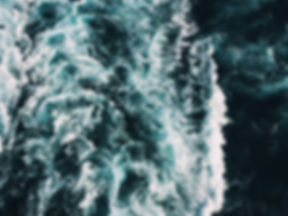


"Later down the road of life, I made the discovery that salt water was also good for the mental abrasions one inevitably acquires on land."
-Jimmy Buffett
12
Introduction
While it might be convenient to imagine the ocean as one gigantic bathtub of salt water, the chemistry of the oceans is quite complex and ocean water in one location is far from the same as ocean water from another. Even within a single ocean (or for that matter a much smaller body of water), there is considerable variability in the actual characteristics of seawater. This investigation will take a close-up look at the chemistry of ocean water and its effects on a variety of marine characteristics.
Basic physics and your background in atmospheric science has already shown you the relationships between such atmospheric properties as temperature, pressure and volume so it should come as no surprise the same relationships exist in seawater. However, since we are now dealing with a liquid, additional factors like salinity and dissolved gases can also be factored into our equations.
Recall, for instance, that water is a key absorber of incoming infrared radiation from the Sun so as water is heated unevenly, it can set up both the vertical and horizontal movement of water in the same manner as wind is produced in the atmosphere. This in part is what produces the world’s ocean currents. Back in meteorology, you also learned the atmosphere is a combination of many components (solids, liquids and gases) each of which can have a large influence on the atmosphere’s overall characteristics. This E-Unit will begin to take a look at how the chemistry of seawater itself plays a part in supporting not only marine life but all life on Earth.

A deep sea hydrothermal vent. These noxious sulfur- belching volcanic features now known to exist in many locations across the planet are the source of some of the most bizarre ecosystems found on the planet. Image: NOAA
Heat: The Energy that Makes the World Go Around
The planet's oceans take up 71% of the surface and represent the single largest climate-affecting features on the Earth. They are responsible for most of the Earth's climate zones and their interaction with the atmosphere are responsible for some of the most violent forms of weather Man has ever seen. Yet, temperature is also the key behind the oceans' marine food chains and ecosystems which far outnumber the biodiversity found on land. What drives this engine? How does the energy move from one place to another? One way or the other the answers to these questions all come back to temperature.
Surface Temperatures
The surface zone of the ocean (also called the mixing layer) is the vital link between atmosphere and hydrosphere. They are also responsible for the world’s marine climate zones where fully two-thirds of the entire world’s population lives. Like its atmospheric counterparts, ocean surface temperature zones are not just related to latitude; many other factors play into ocean temperature zones. For instance, the interplay between global wind belts exert major influence on the world’s surface ocean currents as does the physical distribution of the planet’s continents. Simply separating the land bridge between the Americas, for instance, would have vast implications on the climate of both continents and would redistribute how warm water is circulated through the Atlantic Ocean.

This chart illustrates the annual temperature distribution patterns of the world's oceans. Notice in particular how temperature is not evenly distributed by latitude alone. Other forces must be at work! Image: abc.net.au
The Thermocline
One of the most important temperature zones in the ocean is known as the thermocline. This region is a permanent zone of rapidly changing temperature which exists between the warmer, well mixed waters of the surface zone and the very cold, high density water of the deep zone. In fact, the zones that are separated by the thermocline are actually inhibited from mixing due to the density differences in the water so, in effect, the thermocline acts like a very effective lid. The exception to this occurs in the water of the poles (especially the Antarctic) where the surface zone is so cold to begin with that the density differences between the surface and deep zones are actually very small and mixing is more common. From a biological standpoint, this mixing is essential to bring up nutrients from the bottom of the ocean to the surface where it supports some of the world’s richest marine food webs (more on this later in the course).
It is also worth noting that smaller, seasonal thermoclines can form near the surface as well as the more permanent one at deeper depths. Recall from meteorology that on breezy nights, air currents near the ground can keep the air next to the surface warmer than on a calm night by mixing the coldest air just above the surface with warmer air higher up. In the same sense, calm seas exposed to the summer sun can warm up intensely but a thermocline often exists just below this uppermost layer of seawater. If a storm would happen to move over a region however, the wave action would mix the warmest surface water with cooler water deeper down in the water column and greatly inhibit a thermocline from forming.

This chart illustrates permanent and seasonal thermoclines off the coast of Bermuda between November 1989 to September 1990. Note how the surface zone (also referred to as the "mixed layer") undergoes sizable change sin its temperature profile based on incoming solar radiation. Image: TAMU
Upwelling
Upwelling is a phenomena whereby cooler, nutrient rich water from deeper depths rises to the surface due to one or more of a variety of surface occurrences. Wind-driven upwelling, for instance, occurs along some near-shore environments where the surface winds blow offshore carrying water with it. Cooler water in turn rises to the surface to replace it. In essence this is the marine equivalent of "mechanical lifting" discussed earlier in the year. A close relative of this is called coastal upwelling where winds blow parallel to the shoreline but through deflection caused by the Coriolis Effect, water currents are angled away from the beach and once again, cooler water rises to the surface to take the place of the displaces water.
Obstruction upwelling is also wind driven but aided by coastal features like headlands or promontories where the water is pulled away from an enclosed area by the passing wind. This type of upwelling tends to be very localized in scale but can create "hotspots" for marine life.
Open ocean upwelling occurs where two opposing surface currents come together and, in the process of diverging away from one another, cause upwelling to occur at the intersection of the two currents. This is especially common along the equator where the two hemisphere’s trade winds converge along the center of the ITCZ.
Finally, in a similar fashion to the driving mechanism behind thermohaline circulation, density-driven upwelling typically occurs to great depths and is created by water bodies of different density interacting with one another. Just like competing high and low pressure systems in the atmosphere, deep water currents will routinely overrun each other (another meteorology term) when dense, cold currents undercut more buoyant currents and force them to the surface. This type of upwelling has been extensively research in the Antarctic and is featured in the notes Oceans-1.

Classic coastal upwelling along the California coast in this NOAA-15 infrared image. As northerly winds blow south along the coast, moving surface water is deflected out to sea and a thin band of very cold, nutrient rich water rises all along the coast. Image: NOAA
Density and Salinity: Small Quantities Do Matter
Besides being the most obvious component of seawater, salinity also places a role in ocean water density since increased amounts of salts in water will produce a denser water body. As you will learn, this fact also plays a major role in an object’s buoyancy when placed in water. Buoyancy is a tricky business for such activities as SCUBA diving and requires a considerable amount of effort to manage as a diver. For example, divers are generally positively buoyant meaning that they will float in water when all of their gear is on. This probably comes as a surprise but gear such as wetsuits and fully filled air cylinders actually add a lot of buoyancy to the diver. So, in order to sink in the water column, divers routinely wear lead weights either on belts or as beanbag-like pouches of BBs in their buoyancy vests. However, the density of seawater and the density of freshwater are different (1.0g/cm3 for freshwater but 1.03 g/cm3 for typical saltwater). As a result, the actual amount of weight a diver will need changes when the diver switches between diving in freshwater and salt water. Since saltwater is denser, less weight is needed in order to create negative buoyancy. For those who spend time at the beach, you might recall that your body is noticeably more buoyant in the ocean as opposed to the hotel’s pool...this all comes down to salinity.

(Top) A global salinity map derived from the Argo program. Argo is an ongoing international marine science project that deploys hundreds of "drifter" salinity probes in the ocean. Once deployed (below left), the probes move where the prevailing currents take them and autonomously descend to various depths to record salinity data before resurfacing once every ten days and relaying their data to passing satellites (below right). These buoys can be tracked via the Internet and their data feeds downloaded by any user. Check out this link to see where the buoys are in real time and how they move through ocean currents. Images: NOAA PMEL


Marine Chemistry Resources
Article: The New Ice Age
Article: Underwater Weather
Worksheet: Marine Chemistry Supplemental I